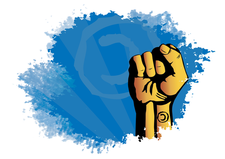The Story of the GPL
Copyleft

The GNU General Public License was born of the simple idea that freedom matters. Yet this simple tool for protecting freedom has another important feature that makes it even more powerful, and that is the ability to build communities.
The scene is 1983, and the high tech world is changing. Computers have been around in some form for a generation, but they are rapidly evolving from the room-sized behemoths of the past into smaller, more versatile systems. Competition is increasing and prices are dropping. And as prices drop, hardware vendors look for other sources of revenue. Corporations start to think of software as a product – independent of the hardware platform. Whole companies, like Microsoft, rise to prominence selling software alone and don't even bother with hardware.
Through this era, the companies that sold software started to become very particular about the rules for using that software, and source code started to become something like a trade secret. When you bought software, you didn't really own anything. You bought a license to use an executable binary, and you didn't even have a good way of knowing what was on that binary.
This new reality was not appealing to the community of programmers who were accustomed to tinkering with computers – in fact, the ability to shape, direct, and modify programs was the main thing they liked about computers. Many were paid handsomely for becoming part of the corporate computer industry, but a few held fast.
[...]
Buy this article as PDF
(incl. VAT)
Buy Linux Magazine
Subscribe to our Linux Newsletters
Find Linux and Open Source Jobs
Subscribe to our ADMIN Newsletters
Support Our Work
Linux Magazine content is made possible with support from readers like you. Please consider contributing when you’ve found an article to be beneficial.

News
-
Fedora 43 Has Finally Landed
The Fedora Linux developers have announced their latest release, Fedora 43.
-
KDE Unleashes Plasma 6.5
The Plasma 6.5 desktop environment is now available with new features, improvements, and the usual bug fixes.
-
Xubuntu Site Possibly Hacked
It appears that the Xubuntu site was hacked and briefly served up a malicious ZIP file from its download page.
-
LMDE 7 Now Available
Linux Mint Debian Edition, version 7, has been officially released and is based on upstream Debian.
-
Linux Kernel 6.16 Reaches EOL
Linux kernel 6.16 has reached its end of life, which means you'll need to upgrade to the next stable release, Linux kernel 6.17.
-
Amazon Ditches Android for a Linux-Based OS
Amazon has migrated from Android to the Linux-based Vega OS for its Fire TV.
-
Cairo Dock 3.6 Now Available for More Compositors
If you're a fan of third-party desktop docks, then the latest release of Cairo Dock with Wayland support is for you.
-
System76 Unleashes Pop!_OS 24.04 Beta
System76's first beta of Pop!_OS 24.04 is an impressive feat.
-
Linux Kernel 6.17 is Available
Linus Torvalds has announced that the latest kernel has been released with plenty of core improvements and even more hardware support.
-
Kali Linux 2025.3 Released with New Hacking Tools
If you're a Kali Linux fan, you'll be glad to know that the third release of this famous pen-testing distribution is now available with updates for key components.

